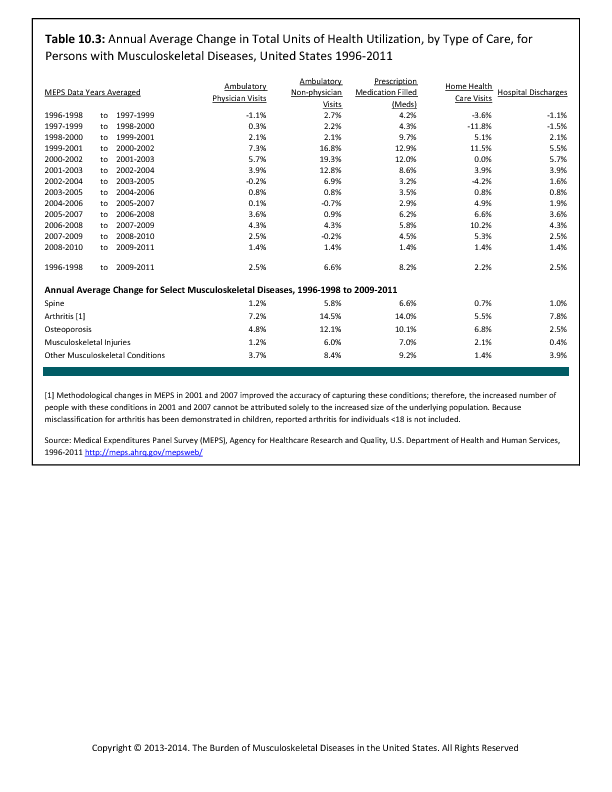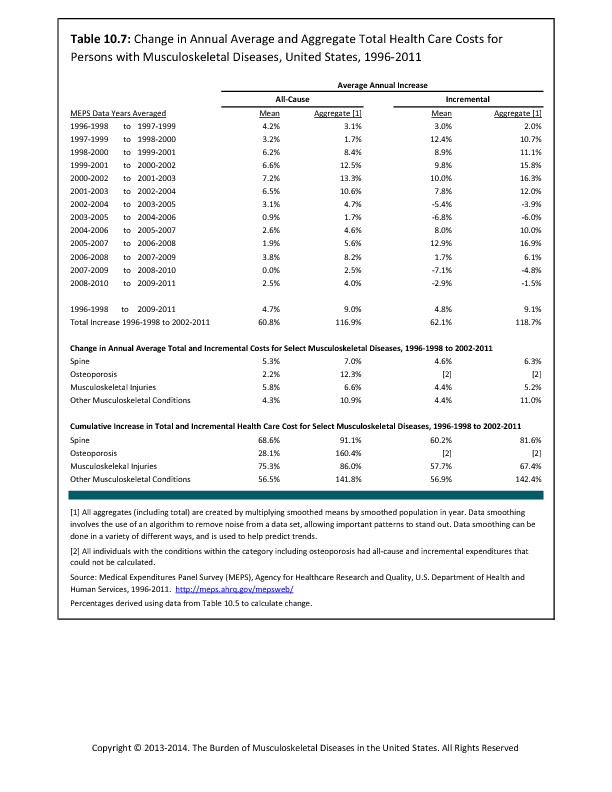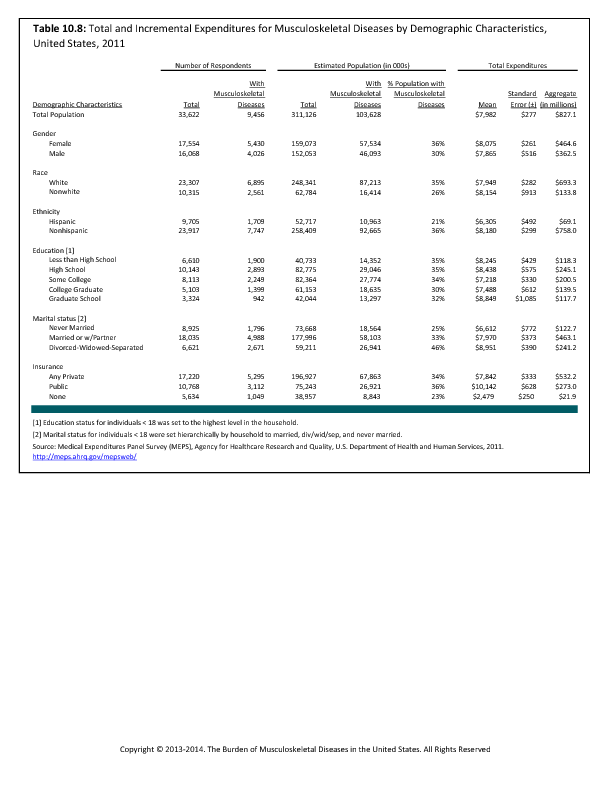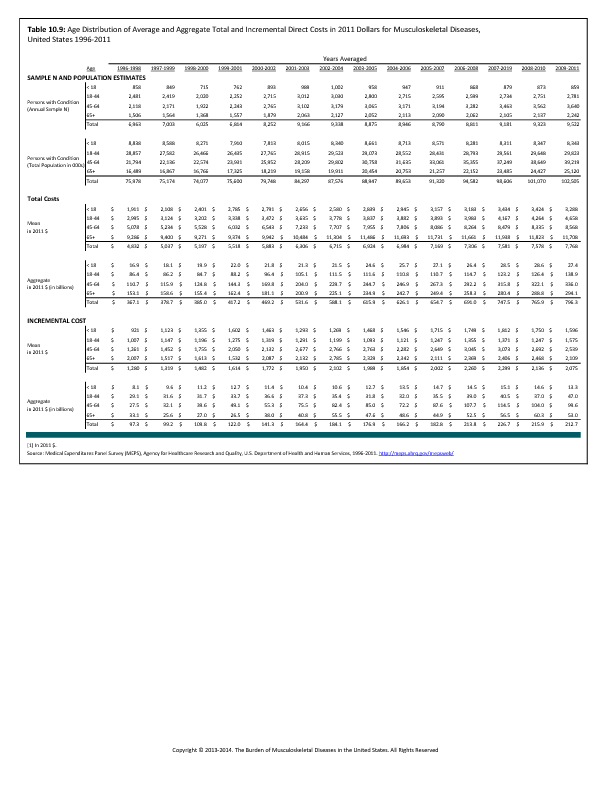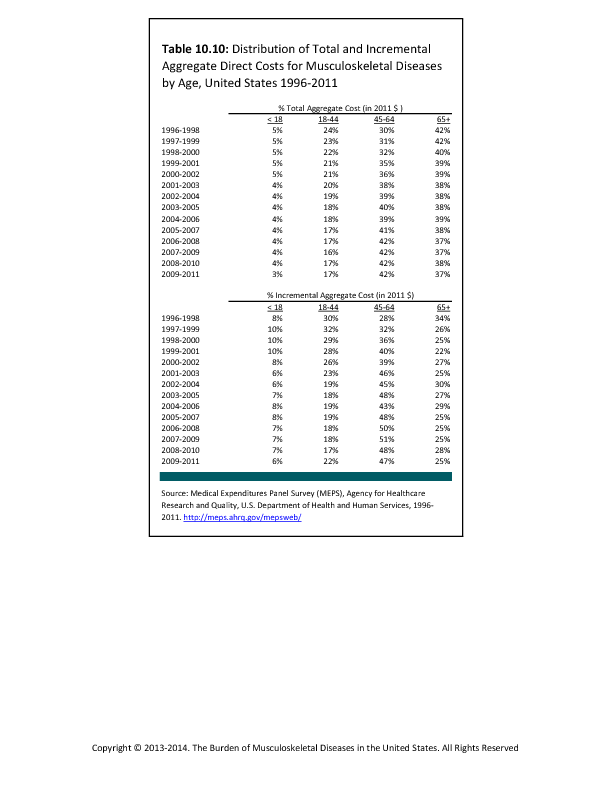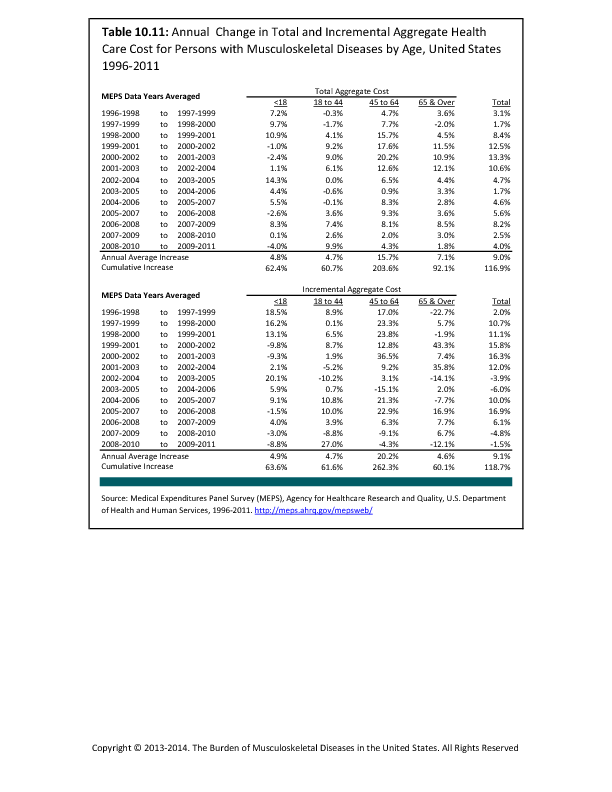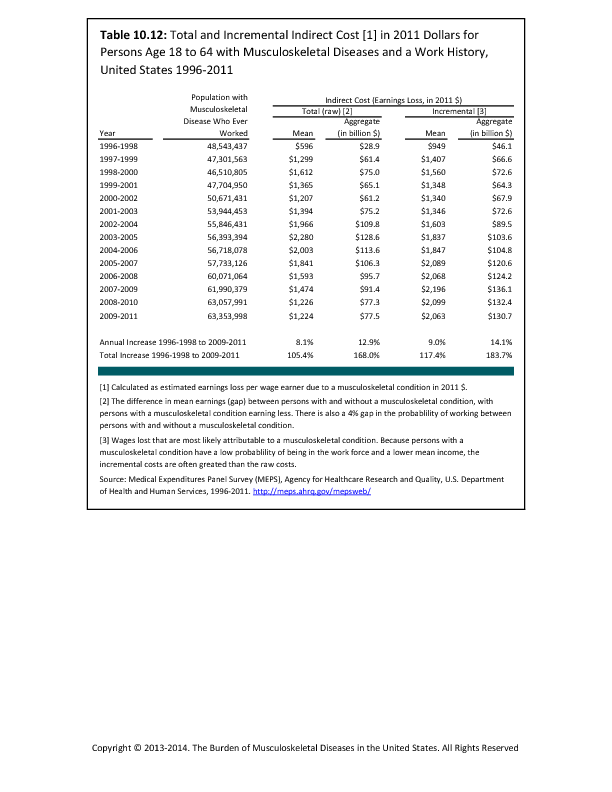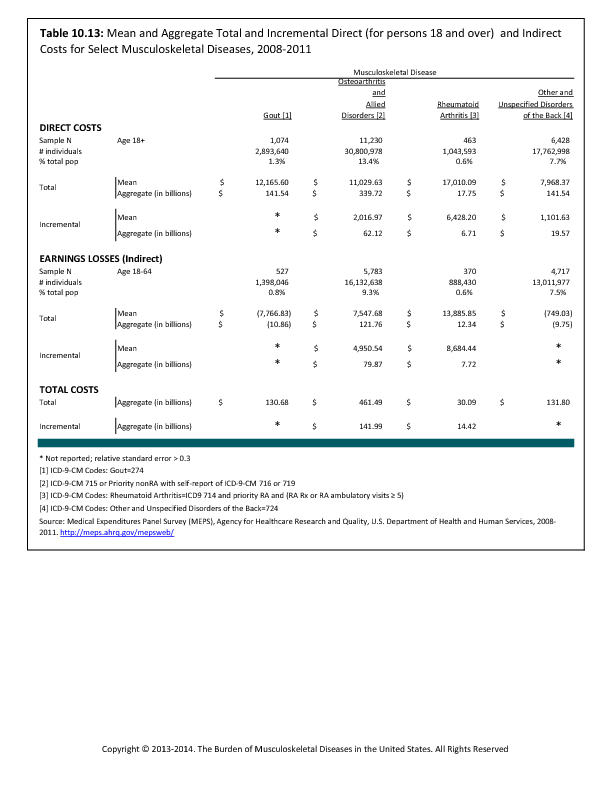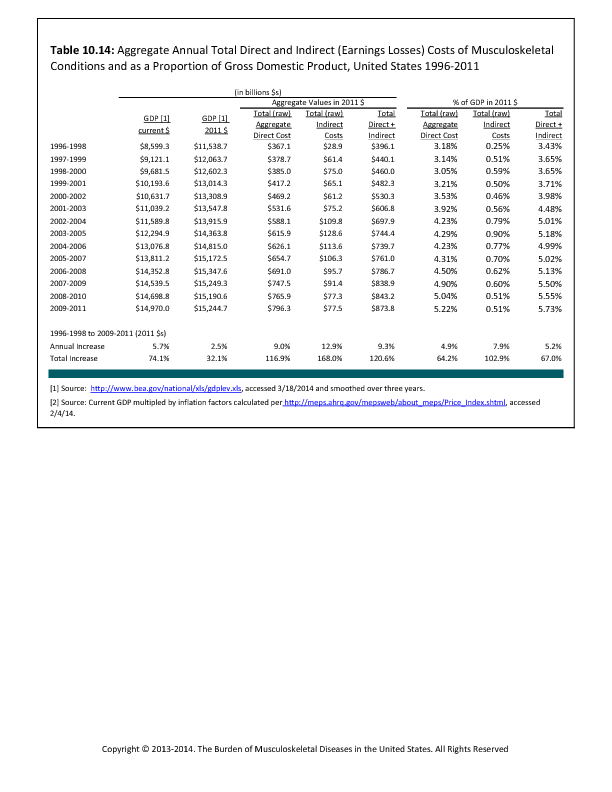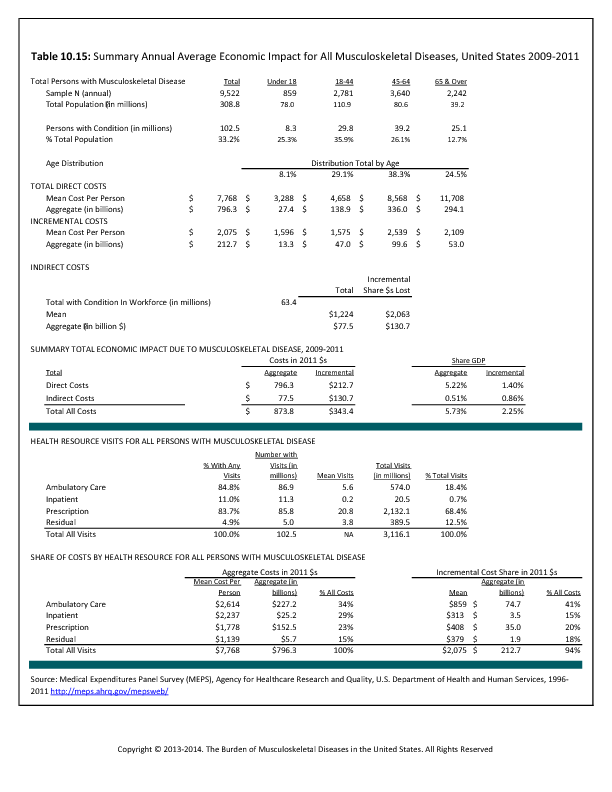X.A.0
Musculoskeletal diseases included in the analysis encompass all conditions discussed in other sections of this website, plus a large number of less common musculoskeletal conditions.
The economic impact includes total and incremental direct and indirect costs due to musculoskeletal conditions.
Direct medical costs include expenditures to doctors and other health care providers, hospitalization or visits to other health care facilities, and medications taken for all causes for patients with a musculoskeletal condition.
Indirect costs are primarily associated with lost wages for persons ages 18 to 64 years, which are considered the typical ages for persons in the workforce. Previous editions of BMUS reported the number of persons in the workforce and was not subset to those between the ages of 18 and 64 years. Retroactively applying this subset to previous years resulted in low numbers of persons in the workforce, as well as lower indirect costs for these years than previously reported.
Incremental costs are those costs most likely attributable to a musculoskeletal disease, and are calculated as the difference in costs between those patients with and without a musculoskeletal condition when matched by similar demographic and health characteristics. Incremental costs are calculated for both direct medical and indirect costs. The methodology for calculating incremental costs was revised in this edition of The Burden of Musculoskeletal Diseases in the United States (BMUS). Comparison with previous editions of BMUS will show smaller cost figures than presented in the past. The new methodology more accurately reflects estimated costs.
Aggregate costs for both direct and indirect costs are the sum of mean costs across all individuals with the condition. Aggregate costs are provided for all forms of musculoskeletal conditions (total) as well as specific conditions, including low back and neck pain (spine), arthritis and joint pain, osteoporosis, musculoskeletal injuries, and a category of "other" for all remaining conditions.
All costs and estimates presented in the economic impact discussion utilize the Medical Expenditures Panel Survey (MEPS) from the Agency for Healthcare Research and Quality, US Department of Health and Human Services (http://meps.ahrq.gov/mepsweb/), and are based on data smoothed over a three-year period to increase the reliability of estimates for small subsets, for example, children with musculoskeletal diseases. Data smoothing is the use of an algorithm to remove noise (data outliers) from a data set, allowing important patterns to stand out and predict trends. The MEPS is a set of large-scale surveys of families and individuals, their medical providers, and employers across the United States. MEPS is the most complete source of data on the cost and use of health care and health insurance coverage.
Gross Domestic Product (GDP), released by the United States Bureau of Economic Analysis (www.bea.gov/national/index.htm#gdp) each year, is the market value of all goods and services produced by labor and property located in the United States. It is the sum of personal expenditures, private investment, government spending (both consumption and investment), and net exports. The GDP is the best known of the national income and product accounts (NIPA), and is often used to create a comparison measure across years.
The economic impact includes total and incremental direct and indirect costs due to musculoskeletal conditions.
Direct medical costs include expenditures to doctors and other health care providers, hospitalization or visits to other health care facilities, and medications taken for all causes for patients with a musculoskeletal condition.
Indirect costs are primarily associated with lost wages for persons ages 18 to 64 years, which are considered the typical ages for persons in the workforce. Previous editions of BMUS reported the number of persons in the workforce and was not subset to those between the ages of 18 and 64 years. Retroactively applying this subset to previous years resulted in low numbers of persons in the workforce, as well as lower indirect costs for these years than previously reported.
Incremental costs are those costs most likely attributable to a musculoskeletal disease, and are calculated as the difference in costs between those patients with and without a musculoskeletal condition when matched by similar demographic and health characteristics. Incremental costs are calculated for both direct medical and indirect costs. The methodology for calculating incremental costs was revised in this edition of The Burden of Musculoskeletal Diseases in the United States (BMUS). Comparison with previous editions of BMUS will show smaller cost figures than presented in the past. The new methodology more accurately reflects estimated costs.
Aggregate costs for both direct and indirect costs are the sum of mean costs across all individuals with the condition. Aggregate costs are provided for all forms of musculoskeletal conditions (total) as well as specific conditions, including low back and neck pain (spine), arthritis and joint pain, osteoporosis, musculoskeletal injuries, and a category of "other" for all remaining conditions.
All costs and estimates presented in the economic impact discussion utilize the Medical Expenditures Panel Survey (MEPS) from the Agency for Healthcare Research and Quality, US Department of Health and Human Services (http://meps.ahrq.gov/mepsweb/), and are based on data smoothed over a three-year period to increase the reliability of estimates for small subsets, for example, children with musculoskeletal diseases. Data smoothing is the use of an algorithm to remove noise (data outliers) from a data set, allowing important patterns to stand out and predict trends. The MEPS is a set of large-scale surveys of families and individuals, their medical providers, and employers across the United States. MEPS is the most complete source of data on the cost and use of health care and health insurance coverage.
Gross Domestic Product (GDP), released by the United States Bureau of Economic Analysis (www.bea.gov/national/index.htm#gdp) each year, is the market value of all goods and services produced by labor and property located in the United States. It is the sum of personal expenditures, private investment, government spending (both consumption and investment), and net exports. The GDP is the best known of the national income and product accounts (NIPA), and is often used to create a comparison measure across years.
Edition:
- 2014

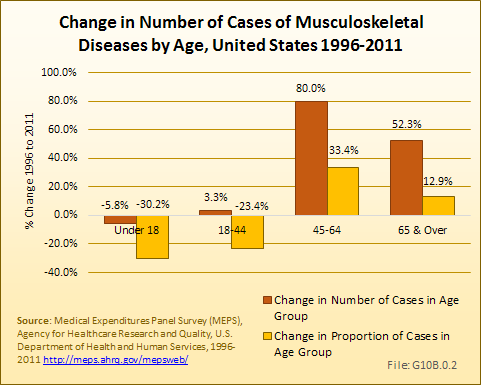

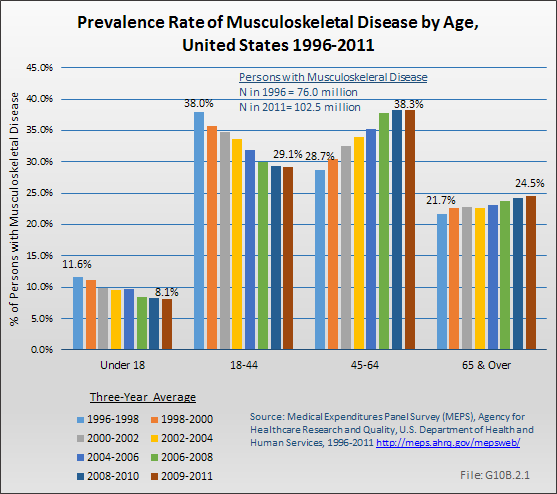


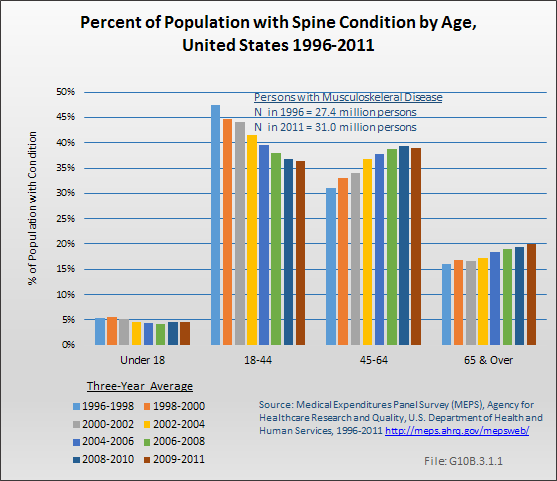
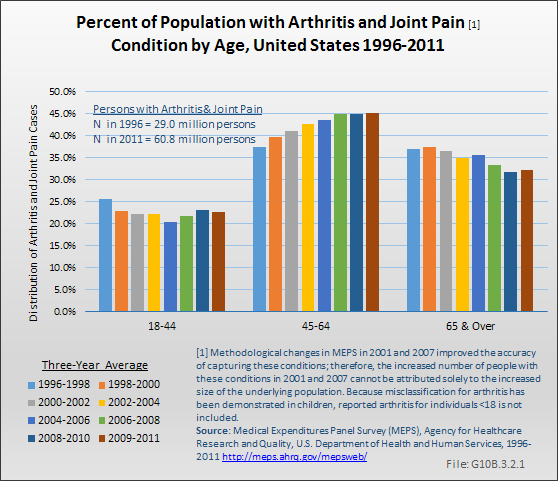

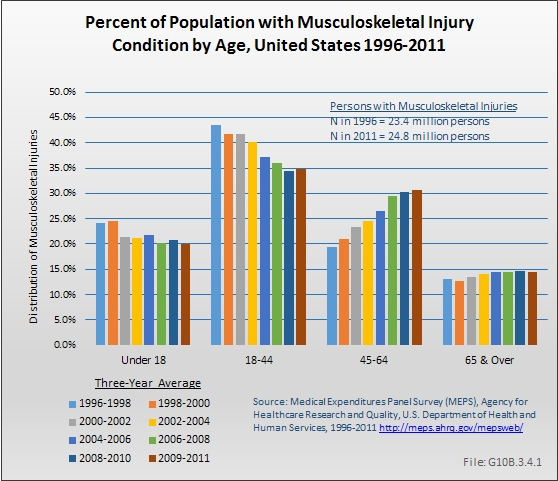
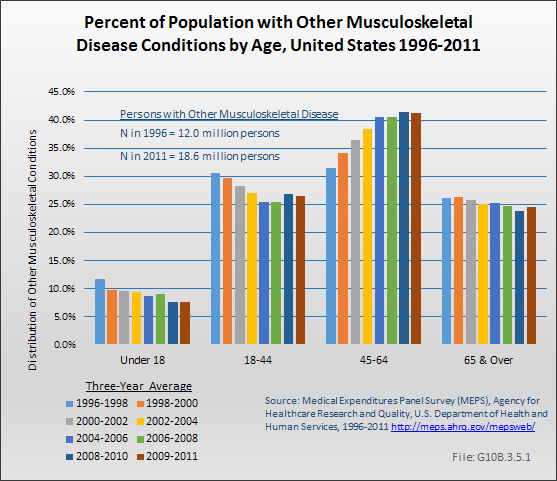
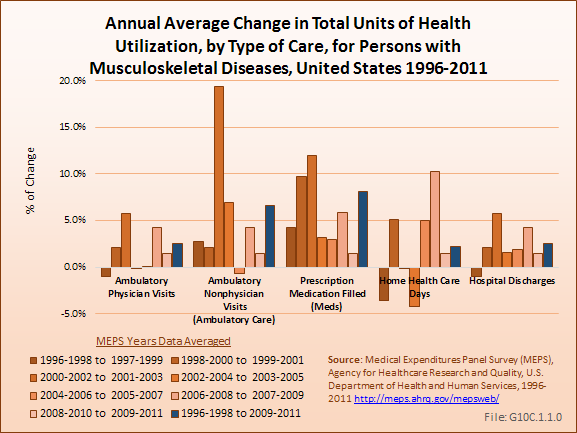
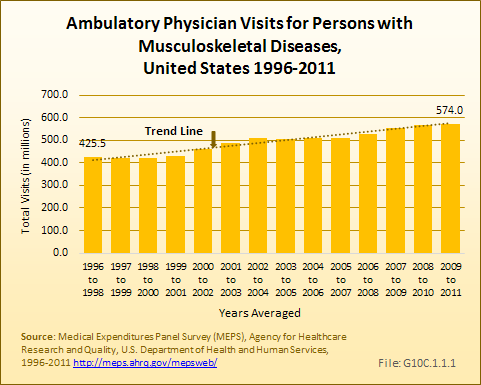
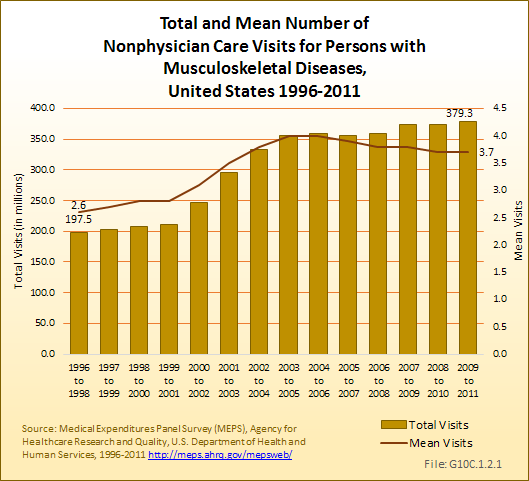
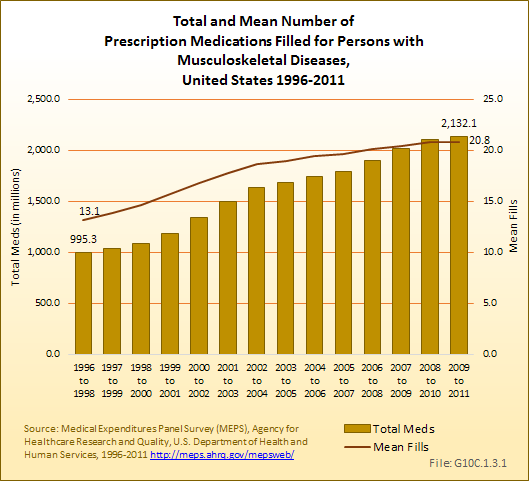

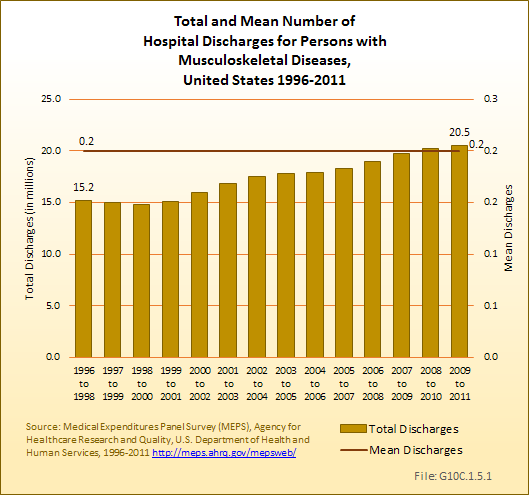


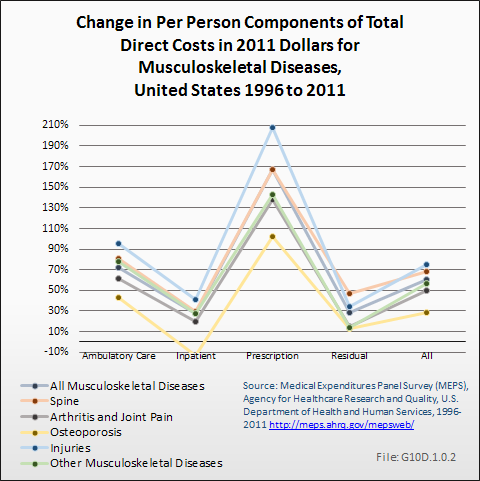
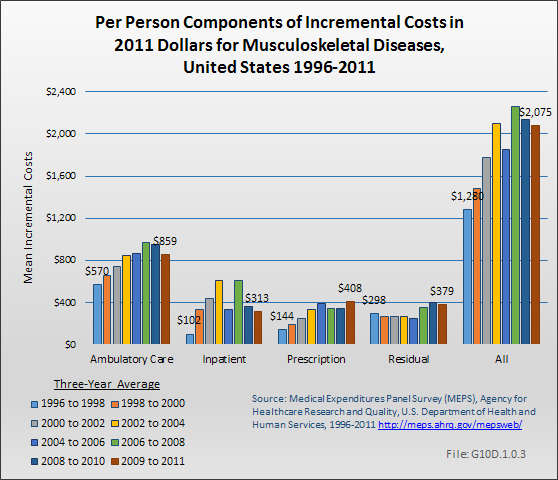
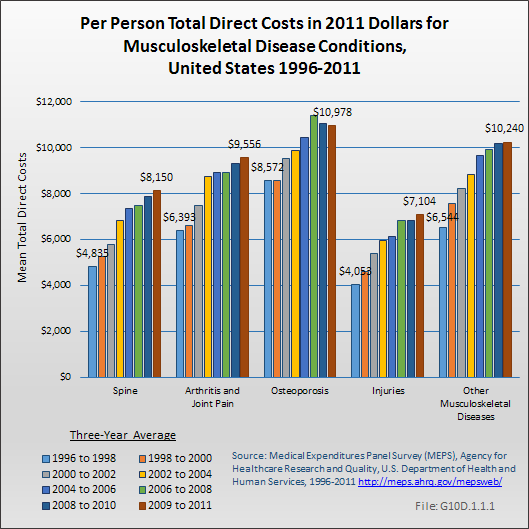

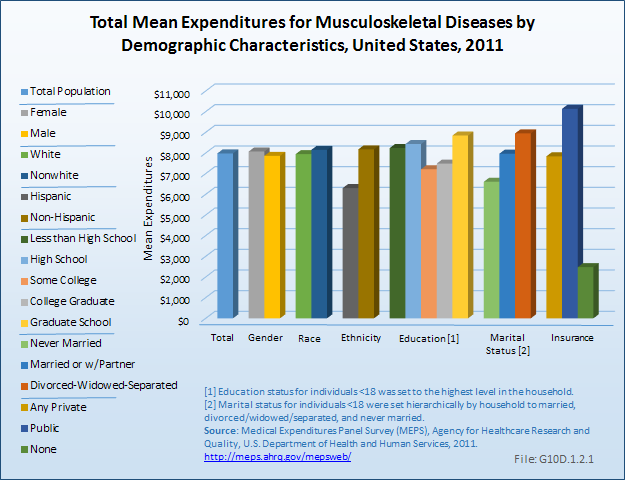
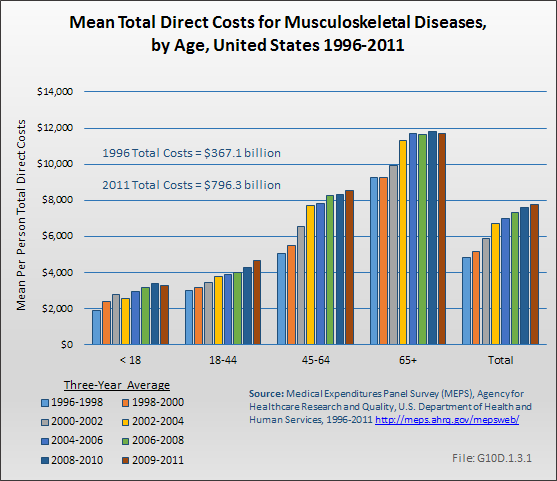
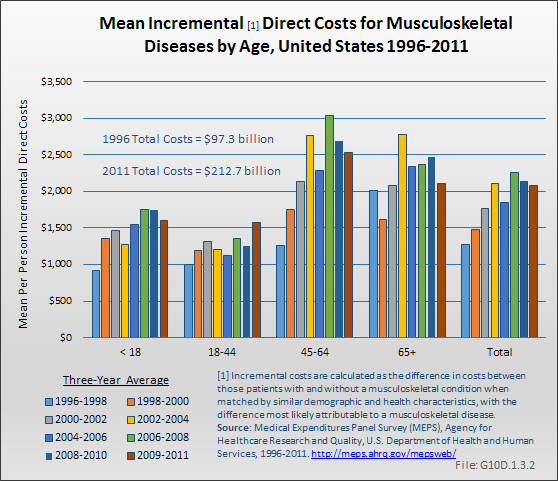


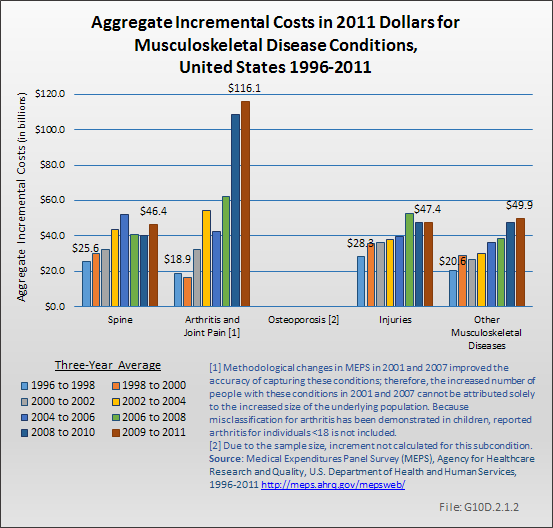
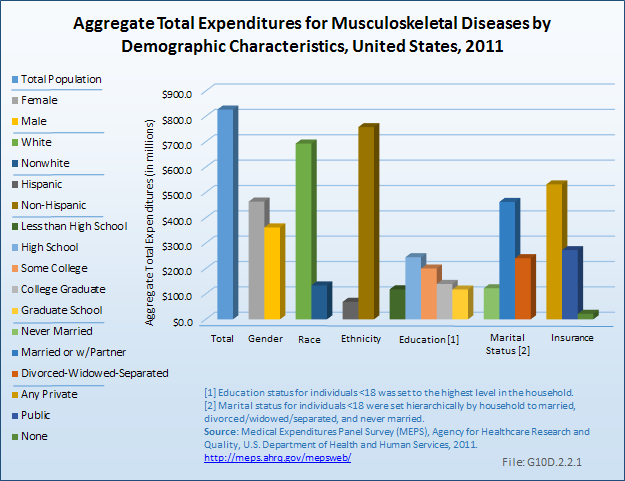



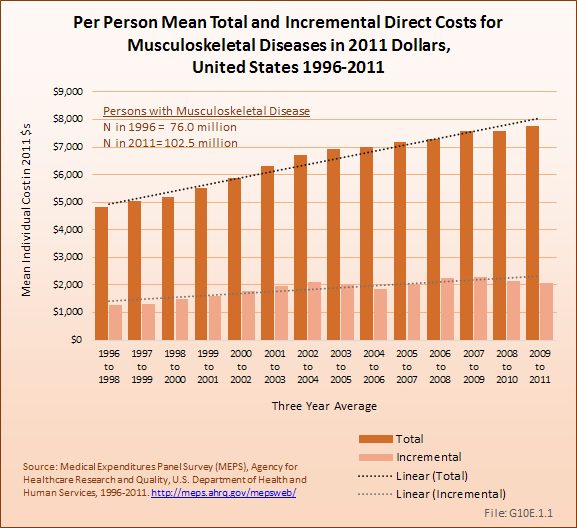

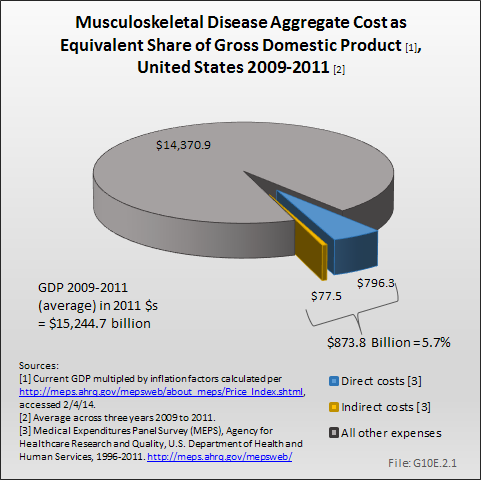
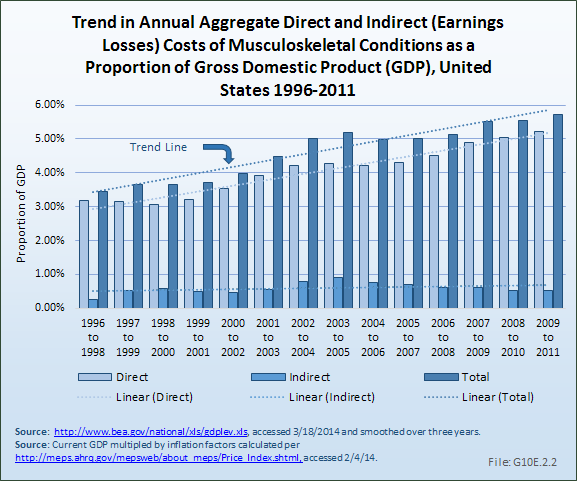

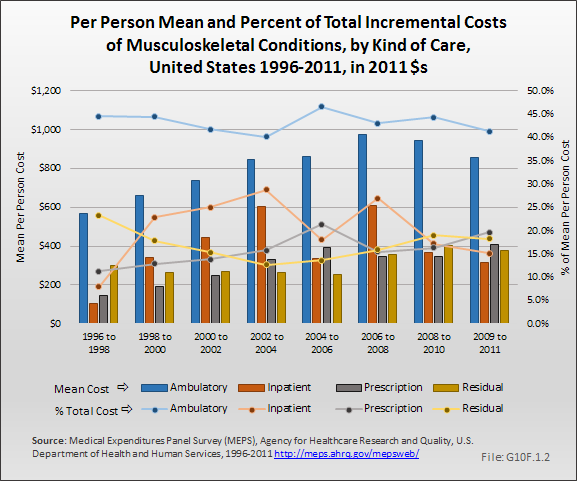
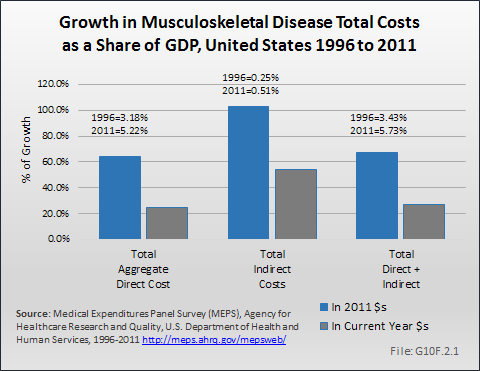
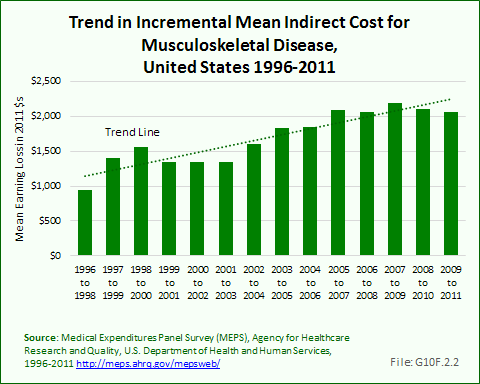

 Download as CSV
Download as CSV


